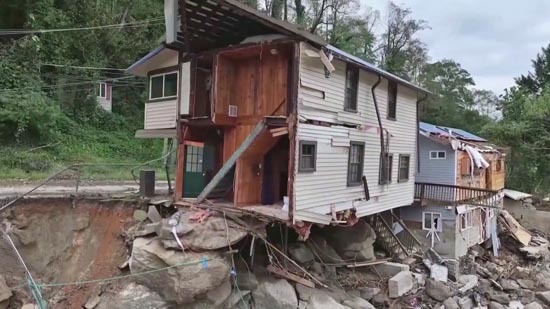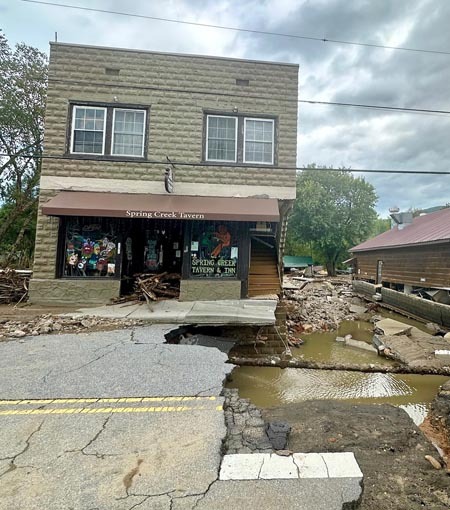One Year After Hurricane Helene
What recovery has achieved, what challenges remain, and signs of resilience and thriving.

Here’s a look at how North Carolina (especially the western, mountain region) is doing about a year after Hurricane Helene.
What Has Gone Well; Signs of Recovery
Large-Scale Funding & Planning
- The state has put together a $1.4 billion Action Plan (RenewNC) to rebuild homes and revitalize the economy under the HUD Community Development Block Grant Disaster Recovery (CDBG-DR) program. Residents can find information, apply for assistance, and report concerns through the Governor’s Recovery Office online. Go to www.wncrecovery.nc.gov.
- Over $1.65 billion in federal block grants has been awarded, including $1.43 billion for state government and about $225 million for Asheville alone. The funds are earmarked for rebuilding homes, repairing infrastructure (schools, water treatment, roads), and helping small businesses.
Recovery Offices & New Structures for Oversight
- The NC Department of Commerce has created a Division of Community Revitalization to manage recovery and ensure efficient implementation of the recovery funds.
- A Governor’s Recovery Office was established to coordinate efforts.
Housing, Workforce, and Business Support
- Money has been allocated for disaster-related unemployment benefits ($91 million paid) and for employment/training via workforce boards. Organizations like CORE are rehabilitating homes and elevating them to improve resilience (e.g., 25 homes in Alan Campos in Buncombe County) to help families return safely.
- Banks and private sector actors have stepped in, e.g. Truist with +/- $650 million in loans, grants, and investments geared toward housing, infrastructure, and small business recovery.
Reopening of Key Tourist Assets & Parks
- Chimney Rock State Park reopened about nine months after being damaged; the entrance bridge was rebuilt (temporarily), roads repaired, etc. This is a sign of recovery not just for public infrastructure but for tourism and local business.
- Similarly, the Biltmore Estate reopened after flood damage, enabling tourism and local economic activity to pick up.
Continued Federal & Community Support
- FEMA and other federal agencies have been heavily involved with cleanup, restoring utilities, infrastructure repair, flood insurance support, etc.
- Nonprofits are doing long-term housing repairs and recovery work which helps stabilize lives (homes, foundations, flood mitigation) while local economies rebuild.

What’s Still Hard; Ongoing Challenges
Housing Crisis
Even months after the storm, many people are struggling with affordable housing: homes destroyed or damaged, rental vacancy rates extremely low, many displaced, some still in temporary shelters.
Economic Losses are Very Large
- The estimated total damage and need is enormous: about $16 billion, including approximately $3 billion in physical property damage and $12-13 billion in interrupted business revenue and economic losses.
- Agriculture, especially small farms, orchards, nursery businesses, suffered heavily. Losses include crop destruction, topsoil washed away, and damaged equipment, impacting both immediate food supply and long-term agricultural income.
Infrastructure Damage and Access Issues
- Roads, bridges, and communications lines were heavily damaged. Some remain impassable or slow to repair.
- Power and water restoration took time; some communities still dealing with delayed utility recovery.
Environmental Damage & Future Risk
- Massive loss of tree cover, including in forests and urban canopies, heightens vulnerability to future floods, heat, and erosion.
- Soil erosion, sedimentation, and risk of flash flooding remain major concerns.
Community Frustration & Recovery Pace
- Many people have expressed dissatisfaction with the speed and clarity of response as well as homeowner’s insurance claims and rebuilding. These indicate significant expectations that more should have been completed by now.
- In some areas, even almost a year later, not a single home had been rebuilt in some hardest hit spots.
Overall Assessment: How NC is Thriving Despite the Storm
Resilience & Community Mobilization – Communities, nonprofits, and state agencies have shown that they have the capacity to mobilize and coordinate under immense stress. The reopening of parks and attractions shows not just physical infrastructure recovery, but morale, economic activity, and identity restoration.
Large-Scale Investments and Forward Planning – With big funding packages, job and housing programs, and new administrative structures, NC is laying down a system to not just rebuild, but build back better/more resiliently.
Adaptive Strategies & Better Resilience – Housing is being elevated, flood mitigation is being incorporated, and infrastructure is being assessed for future shocks. This suggests lessons are being learned (e.g. building in more climate resilience, not just returning to previous conditions).
Fastest Progress: Visible Signs
Rutherford County (Hickory Nut Gorge / Chimney Rock area) – Symbolic and economic milestone: Chimney Rock State Park reopened to visitors June 27, 2025, nine months after the storm. That reopening—plus targeted state recovery dollars and local business reopenings—makes Rutherford one of the more visible “back-open” places in WNC.
Tourism Corridors; Park and Attraction Areas (Select Sites in Haywood/Rutherford/Lake Lure Corridors) – Several parks, visitor sites and small-town business districts have reopened in limited form, which helps jobs and local spending even while full repair continues. State tourism advisories and local chambers have been actively encouraging visitors to support open businesses.
Key Industrial Employers Returning – Some important local employers (for example, the high-purity quartz operations in Spruce Pine) resumed operations, which stabilizes payrolls in parts of Mitchell County. That’s helped towns where one or two employers represent a large share of jobs.

Lagging & Slower Recovery: People and Infrastructure Still Face Big Gaps
Madison County (Hot Springs, Marshall) – Due to catastrophic flooding in several communities, many small businesses and homes remain damaged. Recovery resources are still being coordinated, leaving rebuilding slower in parts of the county.
Yancey, McDowell, and Other More Rural High-Rainfall & Stream Corridor Counties – These area suffered severe damage to roads, bridges, and housing. Repairs are expensive and logistically slower, so day-to-day recovery remains uneven.
Parts of Buncombe County Outside Central Asheville (Rural Neighborhoods; Isolated Communities) – Asheville’s core has many businesses open, but many outlying neighborhoods still struggle with housing, water, and road repairs. Countywide recovery has been slowed by infrastructure damage and complex debris/utility reimbursement delays.
Why Recovery is Uneven: Short List of Drivers
Infrastructure Bottlenecks – Road/bridge failures (I-40, US-74A, local connectors) can isolate communities and slow rebuilding and contractor access.
Housing Shortage and Insurance/Funding Gaps – Low rental vacancy rates and slow insurance/aid disbursement leave many households displaced or in temporary housing.
Federal/State Funding Timeline & Administrative Hurdles – Large grants exist but reimbursement delays and policy approvals have slowed some local contracting and infrastructure projects.
Ground-Level Stories: People & Small Businesses “Thriving” or Showing Resilience
Spruce Pine (Mitchell County) – DT’s Blue Ridge Java and other local small business owners have documented rebuilding downtown: preserving the water line as a memory while reopening and adapting their businesses; mining employers also brought back jobs. This is a small-town revival story—local businesses reopening; community foundations coordinating relief.
Chimney Rock Village Businesses – Owners such as Matt Banz and other local entrepreneurs are rebuilding storefronts. The reopening of Chimney Rock State Park is helping restore visitor traffic (though much of the village remains under repair). The mayor and local volunteers have emphasized community determination.
Hot Springs / Madison County Residents and Volunteer Networks – Nonprofits, local organizations, and volunteers (even out-of-area crews) are doing home repairs, water restoration work, and operating community centers that keep neighbors connected while longer repairs are planned.






